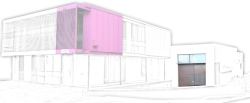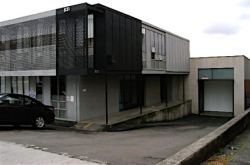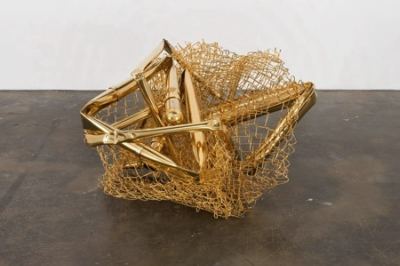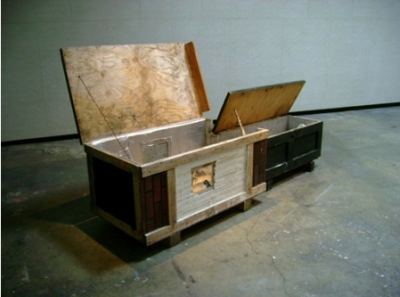Seattle’s Scott Lawrimore opened Lawrimore Project two four years ago in an understated piece of anonymous modernism updated by Lead Pencil’s Annie Han and Daniel Mihalyo. They added nothing to the outside except a steel-coated front door and a ribbon of hot pink paint, like wrapping on a gift.
 Inside, the first room sports a stained, concrete floor, four skylights and wallboard. Past the raw, there’s elegance: a series of galleries with bamboo floors, including a video room, a parlor and a sculpture garden, bounded by chain link. Lawrimore’s office is an inside joke. Because he grew up in a trailer park, Lead Pencil gave him a trailer-park office on concrete blocks with a hot-pink exterior.
Inside, the first room sports a stained, concrete floor, four skylights and wallboard. Past the raw, there’s elegance: a series of galleries with bamboo floors, including a video room, a parlor and a sculpture garden, bounded by chain link. Lawrimore’s office is an inside joke. Because he grew up in a trailer park, Lead Pencil gave him a trailer-park office on concrete blocks with a hot-pink exterior.
Hot pink is the gallery’s signature, which is why, when asked to participate in an exhibit titled Spite House, Matt Browning attacked the pink.
Lawrimore showed up at his gallery to find his pink gone. For the price of a gallon of black house paint, Browning spited his dealer and fellow artists Han and Mihalyo. Because pink is the gallery’s calling card, he replaced it with his own hue. His color and his gallery, inside and out.
In corporate boardrooms, you eat what you kill. You don’t kill, you don’t eat. As curators Yoko Ott and Jessica Powers noted in the catalog, group exhibitions arrive with a similar kind of built-in hostility, the art version of “land grabs and property disputes.”
Spite houses exist across the country, usually dwellings built on small strips of land the owner of an adjoining parcel felt was too small to use and refused to purchase. I’ll show him, says the owner of the tiny parcel, building a structure on the thin slice aimed at destroying the peace of mind and window views of the neighbor.
The most famous spite exhibition entry is Duchamp’s Mile of String from 1942. After surrealists had hung their paintings, he turned the gallery into a spider’s web, making anything but his work impossible to see.
Again, from the catalog:
Spite houses…may as well be shaped like a hand giving you the middle finger with a pair of testicles hanging off the wrist…
 Unless they appear in the early architecture of Frank Gehry, chain-link fences denote prisons, construction sites or industrial wastelands. Aaron Young dipped his chain-link Tumbleweed (above) in 24-kt gold, and also his chain-link fence blocking entry to the video gallery. (What the artist touches turns to gold.) A bent corner makes it theoretically possible for someone who weighs less than 40 pounds to slip through. Everyone else has to stand outside, watching Andrew Dadson‘s two-channel video projection, Roof Gap, at a remove.
Unless they appear in the early architecture of Frank Gehry, chain-link fences denote prisons, construction sites or industrial wastelands. Aaron Young dipped his chain-link Tumbleweed (above) in 24-kt gold, and also his chain-link fence blocking entry to the video gallery. (What the artist touches turns to gold.) A bent corner makes it theoretically possible for someone who weighs less than 40 pounds to slip through. Everyone else has to stand outside, watching Andrew Dadson‘s two-channel video projection, Roof Gap, at a remove.
Bert Rodriguez built a white wall with his father, a repeat of a performance in Miami where the two at long last learn to work together and incidentally partially block entry. SuttonBeresCuller built a wall that completely blocks entry to the gallery containing the group’s sculpture. All that’s visible from the crack is the shadow of a sculpture stand.
Back to Dadson: He painted his neighbor’s lawn black and photographed it, oddly affecting. A vase of white roses standing in black in are slowly through their veins turning black. Titled Should Love Come First, it refers to a piece Robert Rauschenberg made for Jasper Johns, the answer being, apparently, no.
 Elias Hansen (with Herman Beans) built a coffin that functions as a rough/ready shelter, image above. One person could live there, awaiting the demise of the other. The Place I Used To Live is a bum’s camp equipped with survivalist’s essentials but located high on a wall, making it inaccessible.
Elias Hansen (with Herman Beans) built a coffin that functions as a rough/ready shelter, image above. One person could live there, awaiting the demise of the other. The Place I Used To Live is a bum’s camp equipped with survivalist’s essentials but located high on a wall, making it inaccessible.
Christian Kliegel reconfigured the gallery’s spaces from the roof, marking them out in duct tape. The rubble he found there now rests against indoor pillars, bringing the outside in.
Through Sept. 12. Lawrimore invited four writers to consider the theme. From those essays:
Joel Felix:
The spite house exposes the natural hostility buried in cooperation. Once I understand your motives to inhabit (own a) space, I will block them with a small, useless building on my grounds..,.These are the darker rights of my sovereignty.
Robert Mittenthal:
The aggressive artist marks his territory, carefully pissing away time – sitting on the egg with the hope that it will begin to resemble himself. Even the faint possibiity of being spited, the possibility that some heathen may transgress his invisible or intagible boundaries, invites negative ease.
Will Owen:
Spite homes lie in the collapsing human space of a house as it unveils the intentions of its development: a contortion, obstruction, repulsion and cast of our disembodied fecundity.
Tabitha Brown:
Placing things where they’re not meant to be reflects a kind of striving. Fueled by the habit of outdoing one’s limitations, the restrictive order of these modules makes waste and economic struggle inevitable. But it also makes possible the limitless permutations of surprise. ..
The function of the object obstructing our view is apocryphal. Contrary to all appperances, though, it serves one. It’s obviously not here to resolve conflict. But id does solve a problem. It answers the question of what we do now.
Like art, it begins to appreciate.



Leave a Reply